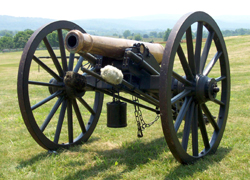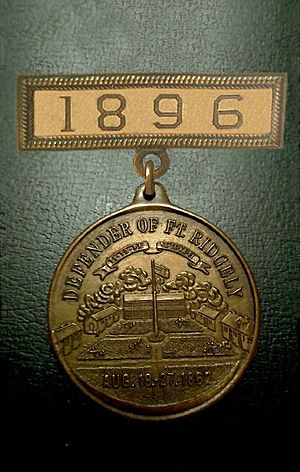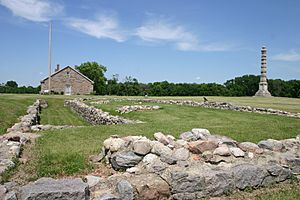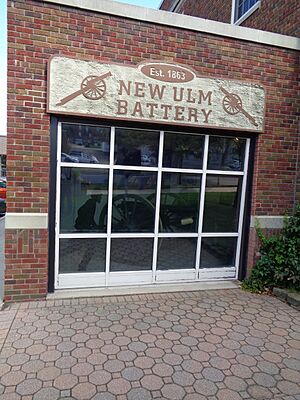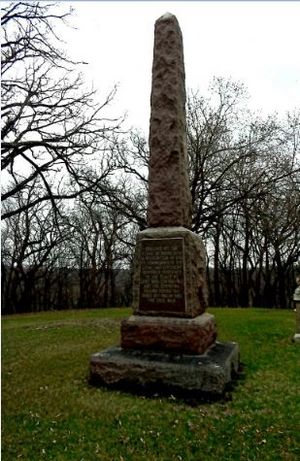Fort Ridgely facts for kids
Quick facts for kids |
|
|
Fort Ridgely
|
|
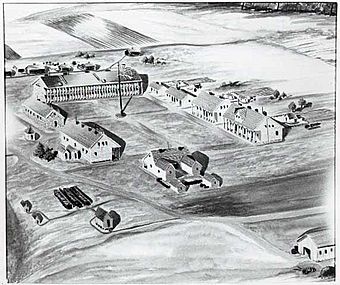
Fort Ridgely in 1862
|
|
| Location | Nicollet County, south of Fairfax, Minnesota |
|---|---|
| Built | 1853 |
| Architectural style | unpallisaded frontier fort |
| NRHP reference No. | 70000304 |
| Added to NRHP | December 02, 1970 |
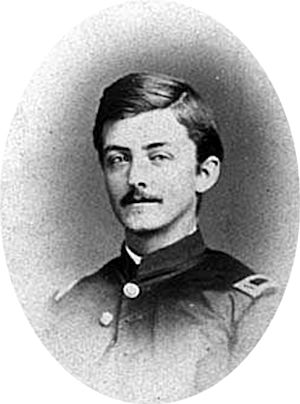
Fort Ridgely was an important United States Army outpost on the frontier. It was built between 1853 and 1854 in what was then Minnesota Territory. The Sioux people called it Esa Tonka. The fort was located on a hill overlooking the Minnesota River, southwest of Fairfax, Minnesota.
Interestingly, Fort Ridgely did not have strong defensive walls, palisades, or guard towers like many other forts. Part of the land around the fort was set aside for the Mdewakanton and Wahpekute tribes. The Army first called it the "New Post on the Upper Minnesota." Later, it was named after two Army officers, Randolph and Lott Henderson Ridgely, who died during the Mexican–American War.
Contents
History of Fort Ridgely
Building the Fort
The War Department hired Mr. Jessie H. Pomeroy to build Fort Ridgely and Fort Ripley. At Fort Ridgely, two companies of soldiers helped with the construction. They quarried granite from two miles away and brought it to the site. They built a large stone barracks that could house 400 men. This barracks formed the east side of the fort's main parade ground, which was 90 square yards.
In 1854–55, the government approved money to clear trees for a military road. This road went from St Anthony Falls to Fort Ridgely. Later, in 1856, more money was approved to build a wagon road from Fort Ridgely all the way to South Pass in Nebraska Territory.
The Spirit Lake Incident
In March 1857, a terrible event known as the Spirit Lake Massacre happened in Iowa, near the Minnesota border. Fort Ridgely sent troops, led by Captain Bee, to investigate. They found that a group led by Inkpaduta had left the area.
A 14-year-old girl named Abbie Gardner was the only survivor and was taken captive for four months. Later, two Wahpeton men helped arrange her release. She was brought to the Upper Sioux Agency, then to Fort Ridgely, and finally traveled by riverboat to St. Paul.
The Dakota War of 1862
Fort Ridgely played a very important role in the Dakota War of 1862. It was one of the few forts in American history to be attacked in the way it was.
On August 18, Captain Marsh, the fort's commander, took most of his soldiers to the Lower Sioux Agency. He had heard reports that the agency was under attack. Sadly, Captain Marsh and his men were attacked while stopping for water. This event is known as the Battle of Redwood Ferry, and Captain Marsh was killed.
Earlier that month, another officer, 1st Lt. Sheehan, had arrived at Fort Ridgely from Fort Ripley. He brought two small cannons and 40 men to help with a food distribution at the Upper Sioux Agency. After successfully helping there, Lt. Sheehan and his men started to return to their own fort.
However, when Captain Marsh learned of the fighting, he sent a messenger to catch Lt. Sheehan. Sheehan and his men were about 40 miles away. They quickly marched back through the night, arriving at Fort Ridgely by noon. Their return greatly strengthened the fort's defenses.
The Sioux warriors, led by Little Crow, attacked Fort Ridgely twice. These attacks happened on August 20 and August 22. About 230 defenders, including soldiers, local militia, and settlers, faced off against 800 Mdewakanton and Wahpekute warriors. The fort's cannons were crucial in fighting off the attacks. Ordinance Sergeant John Jones was a regular Army soldier at the fort. He helped organize men with artillery experience to operate the cannons. This allowed the cannons to fire almost non-stop when needed.
After the attacks, Colonel Sibley arrived with more soldiers. He sent out groups to bury the dead across the frontier. One of these groups was ambushed in the Battle of Birch Coulee. Lt. Sheehan and his men were part of the relief force that helped them.
Important Officers at Fort Ridgely
Many notable officers served at Fort Ridgely. Some of them later became famous generals:
- Major Samuel Woods was the first commander of the fort from 1852–53.
- Major George W. Patten commanded the post twice and lost a hand in the Mexican-American War.
- Lt. Alfred Sulley later became a Major General during the Indian Wars.
- Lt. Winfield Scott Hancock served in 1853 and later became a Major General.
- Capt. John J. Abercrombie also served at Fort Ripley and established Fort Abercrombie.
- Major Thomas W. Sherman was at the fort when it became an Artillery School. He later became a Major General.
- Capt. John S. Marsh was killed in action at Redwood Ferry in 1862.
- 2nd Lt. Thomas P. Gere took command after Captain Marsh died. He later received the Medal of Honor.
- 1st Lt. Timothy J. Sheehan took command from Lt. Gere. He was wounded twice defending the fort.
- Capt. Barnard Bee later became a Confederate General and is famous for giving Stonewall Jackson his nickname.
- Major J.C. Pemberton later became a Confederate Lt. General and surrendered to Ulysses Grant at Vicksburg.
Units Stationed at the Fort
Over the years, many different military units were assigned to Fort Ridgely. These included companies from the 2nd, 6th, and 10th Infantry Regiments of the U.S. Army. Artillery units also served there.
Until 1859, the fort usually had three companies of infantry, each with 30-40 men. In 1859, the Army made Fort Ridgely an Artillery School for Practice. They brought in six cannons of different sizes for training.
During the Civil War, volunteer regiments from Minnesota took the place of regular army units. Many different Minnesota infantry and cavalry regiments served at Fort Ridgely.
The 1864 Wagon Train
On July 15, 1864, Captain James L. Fisk led a group of 97 wagons filled with pioneers from Fort Ridgely. They were heading west to the gold fields in Montana Territory. They met a small escort from Fort Rice.
About 180 miles west, the wagon train encountered warriors led by Sitting bull. The pioneers quickly built a circular defense out of sod, which they called Fort Dilts. A rescue team, including soldiers from Minnesota, was sent from Fort Ridgely. They rescued the wagon train on September 20.
Fort Ridgely is Abandoned
In 1865, Captain Kellogg, the commander of Fort Ridgely, helped establish three settlements for friendly Sioux people.
The Army officially left Fort Ridgely in 1867. The soldiers were moved to Fort Wadsworth. After the Army left, civilians moved into the empty buildings. Later, they took the buildings apart to use the materials for other construction. One of the fort's cannons was given to the New Ulm Battery in 1863.
State Recognition and Monuments
In 1895, the Minnesota government approved money to build a monument. This monument would honor the citizens who defended Fort Ridgely. On August 20, 1896, the granite monument was dedicated. Many of the surviving defenders attended the ceremony. A former artilleryman named Werner Boesch had special medals made for the occasion. On the medal, he included a quote from Big Eagle about the fort: "Ti-Yo-Pa Na-Ta-Ka-Pi," which means "They Kept the Door Shut."
The State also built another large monument in 1914. This one honored Chief Mou-zoo-mau-nee and the Mille Lacs Band of Ojibwe. Chief Mou-zoo-mau-nee had sent 300 warriors to help defend Fort Ripley during the uprising. A large ceremony was held, and the Mille Lacs band sent representatives.
In June 1918, the 6th Battalion of the Minnesota Home Guard used Fort Ridgely as a camp site.
Fort Ridgely Today
Today, archaeologists have uncovered the foundations of the fort's original buildings. The Minnesota Historical Society now takes care of the public part of the site, which is within Fort Ridgely State Park. The old commissary building, which was partly rebuilt in the 1930s, now holds the Park's museum. Fort Ridgely was added to the National Register of Historic Places in 1970. Much of the park was added in 1989.
See also




